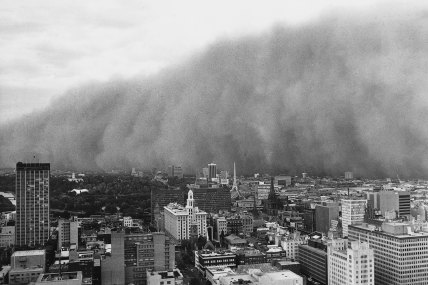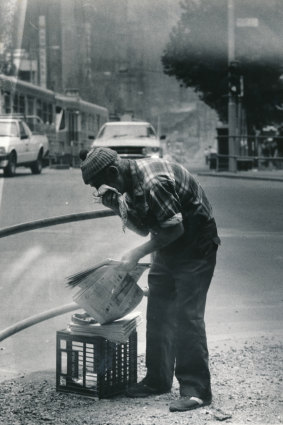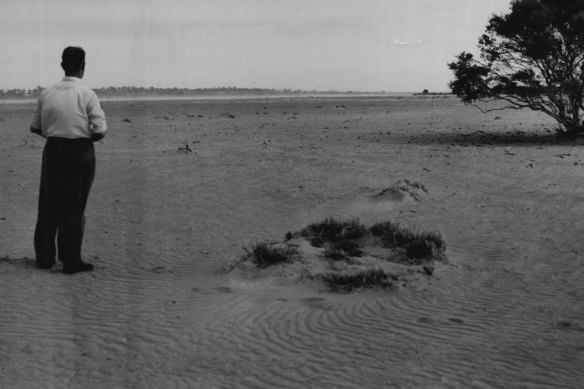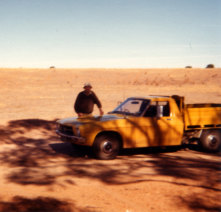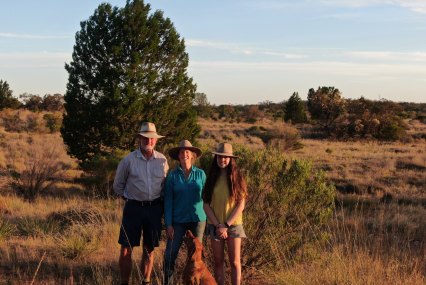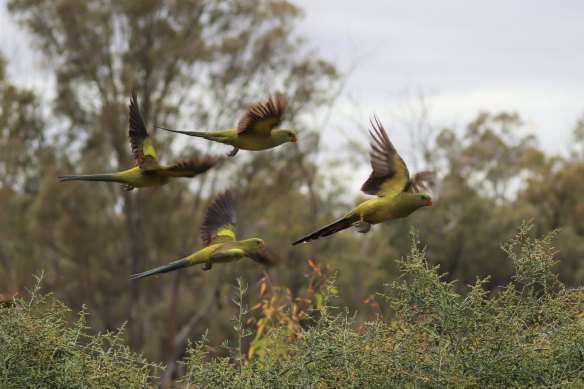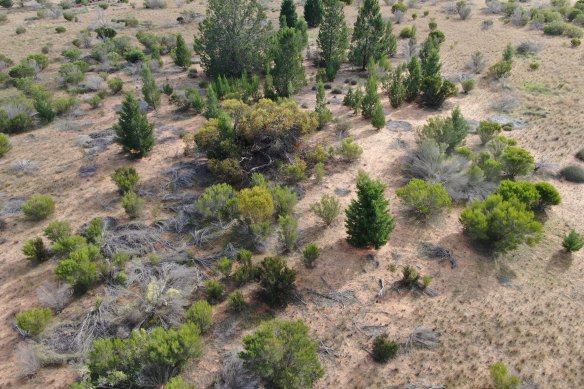The storm that swallowed Melbourne and what it taught us
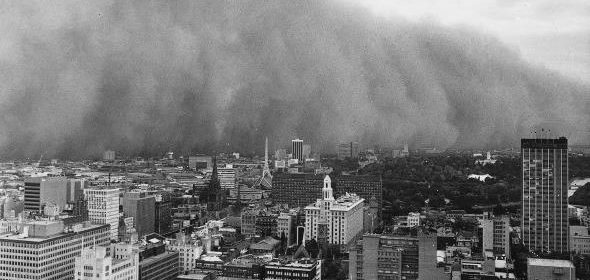
It rolled over Melbourne just before 3pm. The enormous red-brown wave reached 320 metres – twice the height of the Collins Place towers, then the tallest buildings in the CBD.
The dust storm on February 8, 1983, contained a million tonnes of Mallee topsoil, tens of thousands of tonnes of which would be dumped on Melbourne’s suburbs.
The dust storm on February 8, 1983, that blanketed Melbourne.Credit:Melbourne Bureau of Meteorology
As the mercury hit 43.2 degrees, the afternoon sky turned red then black, and residents fled from the swirling gritty cloud. It took weeks for Melburnians to clear their homes and gardens and cars of the fine Mallee dust.
But the dust storm’s impact on the north-west of Victoria took longer to overcome. The then president of the Victorian Farmers and Graziers’ Association estimated it would take 10 years and millions of dollars for farms to recover from the loss of precious topsoil and the destruction of local infrastructure.
It would also forever change the way much of the land was farmed.
The dust storm was the dramatic end point of two years of drought. But the seeds of this event were far older. It was the culmination of 150 years of mismanagement of the fragile but perfectly adapted ecosystem of mallee bushland that once covered most of the semi-arid zone in north-west Victoria.
In fact, mallee – the eucalypts and the woodlands – can be found right across the continent, all the way to Esperance in south-west Western Australia. But in much of north-west Victoria and the bordering lands of South Australia, the woodland is no more. Much of what was once an extraordinarily diverse ecosystem has been reduced to a single crop – wheat or canola or legumes – or to grazing land for cattle or sheep.
There are some remnants of the bushland left alongside roadsides and in national parks like Wyperfeld, Big Desert and Hattah-Kulkyne. But since the late 1800s, more than three-quarters of the mallee woodland has been cleared of the original grasses, plants, bushes and trees that once bound the soil together.
A man tries to protect his face from the 1983 dust storm. Credit:The Age Archives
The story of how this land came to be cleared, and the environmental degradation that resulted – culminating in the 1983 dust storm, the most dramatic of multiple dust storms since the 1900s – is a typical Australian tale of grit and determination, combined with ignorance, folly and government mismanagement.
The “impracticable” land
Victoria’s north-west was the last area to be settled in the colony, says historian Professor Richard Broome, co-author of Mallee Country: Land, People, History, which traces the story of how this region was eventually transformed by white settlers.
What had been an area rich in resources for Indigenous people was regarded by most early explorers as worthless. “The word that sprang from explorers’ lips was ‘impracticable’,” Broome says. In 1875 John Forrest described it as “the most wretched country I have ever seen; not a bit of grass and no water”.
Despite this, pastoralists desperate for unclaimed Victorian land in the late 1840s grazed their sheep on areas where they found grassy patches and saltbush. “People would run as many sheep as they could,” Broome says. It didn’t take long before the hooves had pounded into oblivion the once rich ecosystem around waterholes of succulents, lichens and native grasses.
But the devastation caused by sheep and rabbits was nothing compared to the impact of clearing the land for farming, Broome says. “Sheep destroyed particular areas, but they didn’t have the wide-scale impact of the brutal methods used to clear large areas of country for farming on an industrial scale.”
‘Everything farmers understand now that you shouldn’t do, is what they were doing.’
Farmers cleared the Victorian Mallee from the 1890s, initially taking up reasonably well-watered plots of land nearer the Murray River. But it was government-funded settlement schemes that drove the large-scale clearing of areas previously regarded as too arid to farm.
After World War I, the Soldier Settlement Scheme parcelled out 500,000 acres of land across the Mallee to returned soldiers. “That came about partly out of a sense of duty to the soldiers who had sacrificed so much,” says La Trobe University environmental historian Professor Katie Holmes.
Another scheme in 1922, the Empire Settlement Scheme, lured English settlers to the Mallee with the promise of fertile land, open space and sunny skies. But the schemes were ill-conceived, poorly supported and proved to be a disaster for many of the naive new farmers, not to mention the fragile mallee woodland.
“Everything farmers understand now that you shouldn’t do, is what they were doing,” says Holmes. “Fallowing and then ploughing just loosened the soil, creating the conditions for the significant dust storms for which the Mallee became famous.”
A farmer surveys his Mallee land during drought in the 1940s.Credit:Age archive
Given the poor soil and low rainfall, the 640-acre blocks initially allocated to settlers were also too small to be viable, Holmes says.
“The settlement schemes were just a disaster,” Holmes says. “You look at it now and think ‘how could they let this happen?’ It ended up costing the state many millions of dollars buying out settlers and amalgamating blocks.”
The droughts
Drought and dust storms were part of Mallee life from early on. The Federation Drought started in the late 1890s and lasted till 1903. The land baked so hard it became impossible to plough. In the dust storm of November 1902, witnesses described being unable to see their hands in front of their faces.
In the 1920s the streets, houses and stores of Kondinin were covered with a huge layer of dirt. After a severe drought and dust storm in 1944, just 180 people stayed of the original 1100 who had settled in Kiamal, near Ouyen, in 1925.
The farmers fought back in the interwar period, applying superphosphate fertilisers, planting clovers to replenish the soils and developing techniques to slow soil drift. Rains came with regularity during the 1950s and 1960s, seeming to confirm the belief that “rain follows the plough”.
“There was a feeling that farmers were learning better how to manage dry land farming in the semi-arid region,” Holmes says. It wasn’t to last. “We now know that this was a climatic anomaly, and that rainfall across those decades was much higher than average.”
After some short stints of drought in the early 1970s, the land started to dry again. By 1982 the Mallee was in severe drought.
The dust storm on February 8, 1983 was a severe blow to the Mallee farmers, says Holmes. “It was as if all that learning had come to naught.”
Mallee local Phil Murdoch says he was on his way back to Birchip from a day trip to Echuca on the day of the dust storm. He remembers seeing the sky turning red and then black. “All the lights were on in the town because it was so dark. It was very scary.”
Working in the Victorian Lands Department advising farmers on controlling vermin and noxious weeds, Murdoch says the 1983 dust storm changed the face of farming in the region. “Everyone realised farming couldn’t continue the same way because we were just losing all that topsoil.”
Raakajlim in the Mallee as it was in the 1980s.
After the dust storm, a new form of farming developed in the West Australian mallee was adopted in Victoria where the stubble of the previous crop was left in place, and the new crop sown in rows between the stubble to avoid leaving the soil bare. The “no-till” method has made a huge difference in the region, Murdoch says: “It’s definitely reduced soil drift.”
But even though the number of dust storms has dropped significantly since most Mallee farmers started using no-till methods, the technique has major drawbacks. Weeds that were once ploughed into the ground are instead killed with large quantities of herbicide; herbicide-resistant weeds are becoming a significant concern. The machines that plant between last year’s rows are massive. “That has led to further clearing,” says Holmes.
A different way
As the woodland has diminished so have the birds, mammals and other creatures that for untold millennia made the Mallee their home. Without the little trees and the ecosystems they support, mallee fowl, plains wanderers, curlews and other birdlife have become rare. Since European settlement, one third of all mammal species have also disappeared and another 200 flora and fauna species are listed as threatened.
Murdoch and his wife Fiona are among a small but growing number of landowners attempting to reverse this process. Over the past 20 years they have laboured to revegetate their property “Raakajlim”, 490 hectares of land adjacent to Hattah-Kulkyne National Park, in the hope that one day the mallee fowl and other birds and wildlife will return.
Phil is a retired ranger and Fiona is a restoration ecologist who was in the middle of a doctorate when the couple took on what Fiona describes as “the PhD that never ended”.
The Murdoch family: Phil, Fiona and daughter Emily with their dog Jazz on their property Raakajlim after 20 years of revegetation efforts.
“The first 15 years were just taken up with getting rid of rabbits and weeds,” she says. The couple planted and nurtured thousands of plants, saplings and grasses, watering them weekly to give them a start in the badly degraded soil. Revegetation seemed successful.
“We’d started to build up some good soil cover and the plants were looking great, and then we just got completely smashed by the 2019 drought and too many kangaroos.”
Fiona came up with the idea of installing an electric fence to keep out the goats, feral pigs and kangaroos. “Phil and some of the neighbours laughed at first,” she says. But the couple raised funding and did much of the work themselves.
Installing the 13½-kilometre fence coincided with the recent prolonged La Nina. “The rains have been fantastic for us. The land has responded really well, and with the fence we know that when the dry times come we won’t have that overgrazing pressure,” says Fiona. “But it’s also that the soil has built up carbon and a good biomass of microbes under the soil. I feel pretty confident now that we’ve contained the soil drift that leads to dust storms.”
The couple have been excited to see the return of creatures once common in the area, such as the nationally threatened Regent parrots, as well as the formerly rare pink cockatoos, several species of bats and reptiles.
Rare Regent parrots in flight at Raakajlim.Credit:Fiona Murdoch
They are not the only ones determined to reverse 150 years of destruction of the Mallee habitat. “There are heaps of other people scattered across the Mallee and across Victoria who care about the land and about the wildlife.”
But it’s a slow process. The Murdochs can only revegetate around five hectares a year, and mallee bushland is slow-growing. “It could take 50 years before it approaches anything like its natural state,” Fiona says.
They’re also conscious that what they have created is a relatively small island of habitat in a vast sea of wheat fields. But every bit of habitat helps, they insist: “Small remnants of vegetation can host the only population of a rare plant.”
An aerial shot of some of the replanting.
“The land we look after gives us hope,” Fiona Murdoch says. “But the Mallee landscape is under constant pressure and a dust storm is bigger than one property. So we’re hopeful about the rise of regenerative agriculture to keep the soil healthy and productive. Conservation and farming can co-exist, because they have to.”
Get to the heart of what’s happening with climate change and the environment. Our fortnightly Environment newsletter brings you the news, the issues and the solutions. Sign up here.
Most Viewed in National
From our partners
Source: Read Full Article

